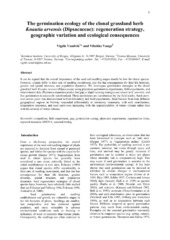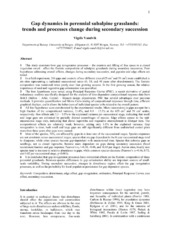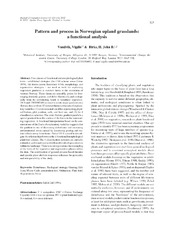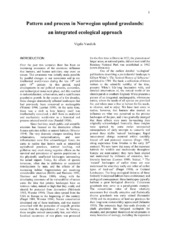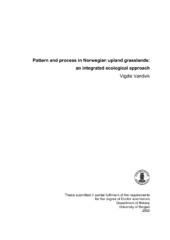| dc.contributor.author | Vandvik, Vigdis | eng |
| dc.date.accessioned | 2006-06-01T08:41:31Z | |
| dc.date.available | 2006-06-01T08:41:31Z | |
| dc.date.issued | 2002-06-04 | eng |
| dc.identifier.isbn | 82-7460-011-8 | en_US |
| dc.identifier.uri | https://hdl.handle.net/1956/1194 | |
| dc.description.abstract | In this thesis I examine community patterns and the effects of disturbances on these patterns within successional subalpine grasslands at summer farms in Norway. On a broad scale, I investigate how environment, land-use history, and spatial variability affect vegetation patterns within and between farms. On a fine scale, I investigate the effect of the creation and revegetation of bare-ground gaps along a secondary successional sequence. Finally, I investigate seed germination responses in subalpine grassland plants, and relate these to the potential for establishment in semi-natural grasslands during succession. The study is based on field data and seed collections from 19 summer farms in two valleys in western and eastern Norway. The data originate from observational field studies via field experiments to phytotron germination trials, and the biological responses monitored range from floristic composition via field recruitment to the timing of germination in individual seeds. The temporal scales and resolutions range from snapshot studies via day-to-day monitoring of germination and four-year field experiments to 40-year chronosequences. The data are analysed using different univariate and multivariate statistical procedures. Three major findings emerge from the study. (1) Disturbance, at scales ranging from the disturbance regimes of entire summer farms via gradients in disturbance intensity within landscapes to fine-scale gaps in a closed vegetation sward, exert considerable influence on the composition and functional traits of species at these various scales. Rare species increased in relative abundance in gaps. (2) The dynamics within fine-scale disturbances, and the responses of individual species to disturbance, change along a secondary successional sequence. This indicates that the processes operating at broad and fine spatial and temporal scales are not independent. (3) The secondary successions, gap revegetation, and regeneration from sown seeds in the field, were slow relative to seminatural vegetation elsewhere. (4) The seeds from subalpine populations of 11 species had consistently high temperature thresholds for germination relative to species from lowland grasslands in Norway and elsewhere. Together, these findings suggest that summer farm grasslands share some common characteristics with semi-natural vegetation elsewhere, but that they also have their own particularities. These may be related to climatic constraints. This study contributes to the knowledge of these systems by demonstrating that land-use changes have had, and will continue to have, dramatic effects on the vegetation and flora of subalpine semi-natural landscapes. The slow secondary successional rates in the mountains may explain why upland semi-natural vegetation is regarded as less immediately threatened than its lowland counterparts. | en_US |
| dc.format.extent | 399081 bytes | eng |
| dc.format.extent | 450912 bytes | eng |
| dc.format.extent | 544301 bytes | eng |
| dc.format.extent | 265105 bytes | eng |
| dc.format.extent | 291698 bytes | eng |
| dc.format.extent | 3791433 bytes | eng |
| dc.format.extent | 175907 bytes | eng |
| dc.format.mimetype | application/pdf | eng |
| dc.format.mimetype | application/pdf | eng |
| dc.format.mimetype | application/pdf | eng |
| dc.format.mimetype | application/pdf | eng |
| dc.format.mimetype | application/pdf | eng |
| dc.format.mimetype | application/pdf | eng |
| dc.format.mimetype | application/pdf | eng |
| dc.language.iso | eng | eng |
| dc.publisher | The University of Bergen | en_US |
| dc.relation.haspart | Paper 1: This is a preprint of an article submitted for consideration in Plant Ecology, Copyright 2006, Kluwer. Plant Ecology is available at <a href"=http://dx.doi.org/10.1023/A:1020322205469"target=_blank>http://dx.doi.org/10.1023/A:1020322205469</a> | en_US |
| dc.relation.haspart | Paper 2: Reprinted from Journal of Vegetation Science, 13, Vandvik, V. and Birks, H.J.B. , Pattern and process in Norwegian uplands grasslands: a functional analysis. 123-134, Copyright 2002, with permission from Opulus Press | en_US |
| dc.relation.haspart | Paper 3: This is a preprint of an article submitted for consideration to Journal of Ecology, Vandvik, V., Gap dynamics an perennial subalpine grasslands: trends and processes change during secondary succession. Copyright 2002, with permission from Blackwell | en_US |
| dc.relation.haspart | Paper 4: Germination and seedling survival in subalpine grassland herbs: can phytotron responses predict field regeneration? Vigdis Vandvik and Reidar Elven. The article is not available in BORA. | en_US |
| dc.relation.haspart | Paper 5: This is a preprint of an article submitted for consideration to Journal of Vegetation Science, Vandvik, V. and Vange, V. , The germination ecology of the perennial grassalnd herb Knautia arvensis (Dipsacaceae): regeneration strategy, geographic variation, and ecological consequences. Copyright 2002, with permission from Opulus Press | en_US |
| dc.subject | Chronosequence | eng |
| dc.subject | Cultural landscape | eng |
| dc.subject | Disturbance | eng |
| dc.subject | Field experiments | eng |
| dc.subject | Functional types | eng |
| dc.subject | Gap revegetation | eng |
| dc.subject | Germination cueing | eng |
| dc.subject | Land-use change | eng |
| dc.subject | Ordination | eng |
| dc.subject | Monte Carlo permutation tests | eng |
| dc.subject | Phytotron experiments | eng |
| dc.subject | Principal response curves | eng |
| dc.subject | Recruitment | eng |
| dc.subject | Regeneration niche | eng |
| dc.subject | (repeated measures)(split-plot) ANOVA | eng |
| dc.subject | Seasonal timing | eng |
| dc.subject | Secondary succession | eng |
| dc.subject | Seed size | eng |
| dc.subject | Variance partitioning | eng |
| dc.title | Pattern and process in Norwegian upland grasslands: an integrated ecological approach. | en_US |
| dc.type | Doctoral thesis | |
| dc.subject.nsi | VDP::Matematikk og Naturvitenskap: 400 | nob |
